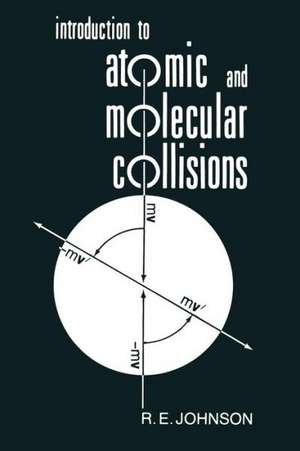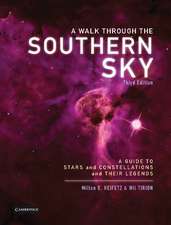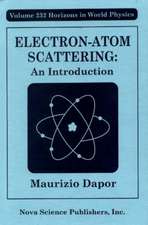Introduction to Atomic and Molecular Collisions
Autor R. E. Johnsonen Limba Engleză Paperback – 4 mai 2012
Preț: 387.96 lei
Nou
Puncte Express: 582
Preț estimativ în valută:
74.26€ • 80.69$ • 62.42£
74.26€ • 80.69$ • 62.42£
Carte tipărită la comandă
Livrare economică 21 aprilie-05 mai
Preluare comenzi: 021 569.72.76
Specificații
ISBN-13: 9781468484502
ISBN-10: 1468484508
Pagini: 308
Ilustrații: 302 p. 11 illus.
Dimensiuni: 152 x 229 x 16 mm
Greutate: 0.41 kg
Ediția:Softcover reprint of the original 1st ed. 1982
Editura: Springer Us
Colecția Springer
Locul publicării:New York, NY, United States
ISBN-10: 1468484508
Pagini: 308
Ilustrații: 302 p. 11 illus.
Dimensiuni: 152 x 229 x 16 mm
Greutate: 0.41 kg
Ediția:Softcover reprint of the original 1st ed. 1982
Editura: Springer Us
Colecția Springer
Locul publicării:New York, NY, United States
Public țintă
ResearchCuprins
1. Application Areas.- Radiation Cascades.- Gas Dynamics.- Gas Lasers.- Plasmas.- Studies of Interaction Potentials and Surfaces.- Summary.- Suggested Reading.- 2. Cross Sections and Rate Constants.- Total Cross Sections.- Inelastic Cross Sections.- Rate Constants.- Cross Section Calculations.- Angular Differential Cross Sections.- Calculation of Angular Differential Cross Sections.- Collision Kinematics: Elastic Collisions.- Center of Mass System.- Kinematics of Inelastic Collisions.- The Classical Deflection Function.- Classical Inelastic Cross Sections.- Exercises.- Suggested Reading.- 3. Waves and Trajectories.- The Wave Equation.- Solutions to the Wave Equation.- Scattering of a Plane Wave.- Scattering Amplitude for Potential Scattering.- The Semiclassical Approximation.- The Born Approximation.- Charge Distributions.- Vibrational and Rotational Levels of Molecules.- Exercises.- Suggested Reading.- 4. Interaction Potentials and Transition Probabilities.- Electrostatic Interaction between Atomic Charge Distributions.- Induced Moments: The Polarizability and the van der Waals Forces.- Wave-Mechanical Treatment of the Interactions.- State Identification and Molecular Symmetries.- The Exchange Interaction.- Transition Probabilities: The Impact Parameter Method.- Rearrangement Collisions: Charge Exchange.- Semiclassical Approximation for Inelastic Differential Cross Sections.- Transitions in the Born Approximation.- Detailed Balance.- Exercises.- Suggested Reading.- 5. Cross Sections and Rate Constants: Results.- Total Differential Cross Sections and Interaction Potentials.- Integrated Total Cross Sections and the Diffusion Cross Section.- Charge Exchange.- Inelastic Energy-Loss Cross Sections.- Molecular Processes.- Exercises.- Suggested Reading.- 6. Application of Results.- Energetic Particle Transport.- The Continuous Slowing-Down Approximation.- Integral Equations for Range and Projected Range.- Stopped-Particle Distribution.- Diffusion of Implanted Particles, Backscattering, and Transmission.- Energy Deposition Effects.- Biological Damage.- Sputtering.- Planetary Escape.- The Ionosphere.- Final Summary.- Exercises.- Suggested Reading.- Appendixes.- A. Delta Functions.- B. CM Deflection Function and Semiclassical Phase Shift.- C. Collision with an Oscillator.- D. Born-Approximation Cross Section and Transition Probabilities.- E. Transport Equations.- F. The Stationary-Phase Approximation.- G. Atomic State Labels.- H. Thomas—Fermi Interaction: Results.- I. Low Energy, Inelastic Cross Sections.- J. Constants and Units.- Author Reference Index.- Interactions, Reactions, and Collisions: References and Results.














